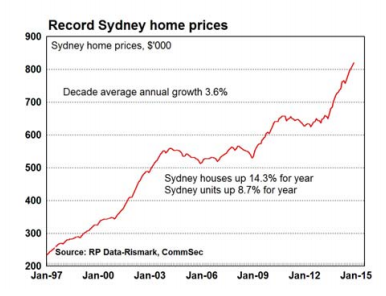
by Chris Becker
Are we seeing a repeat of the 1980’s Gold Coast real estate bubble led by Japanese investors in Sydney?
Perhaps – from Mingtiandia:
China’s outbound investment wave continued to flow into Sydney as buyers from the mainland and Hong Kong acquired more than $1.23 billion worth of major assets during the last two months of 2014.
Most of the investors were major mainland property developers looking to escape the dwindling returns of a slumping Chinese property market. Companies such as Dalian Wanda, Poly Real Estate and Shimao Property all picked up projects in the Australian port city, hoping that their existing clients on the mainland will be keen to buy Sydney apartments, and local consumers will learn to love these Chinese real estate brands.
As reported this morning, there’s is some truth to this as the Chinese property market comes completely off the boil while the Sydney market continues to bubble over.

Surely though purchasing commercial property is of no concern as it has no impact on that bubble? Not if the plans are to add to the burgeoning supply by converting them to apartments as four top Chinese developers (Wanda, Vision, Shimao and Poly Real Estate) scoop them up and their state-owned “competitor” Greenland Group adds to the frenzy:
One of the biggest deals of the quarter happened just a few days before Christmas when Dalian Wanda, the property group controlled by Chinese billionaire Wang Jianlin, bought Gold Fields House... with the intent of converting the building for residential use. Current owner Blackstone in 2012 gained approval to repurpose the tower overlooking Sydney Harbour into 197 luxury apartments.
Although all four of these Chinese developers acquired office assets, they also all appear to have the intent of converting these existing buildings for sale as apartments.
Vision Investment Group is also said to be preparing to acquire another office building, this time at 338 Pitt Street in Sydney, for $84 million. This asset is also said to be slated for conversion into office space.
In developing residential space in Sydney, these four Chinese real estate firms may be following the lead of Shanghai-based Greenland Group which has already acquired four sites in Australia’s commercial centre.
After acquiring its first Sydney project in March 2013, the state-owned developer was able to quickly boost its sales, adding vital new revenues to its bottom line. In the case of that first Sydney project, the demand for Aussie apartments among Greenland’s Chinese clientele was so high that buyers snapped up RMB1.5 billion (US$246 million) of the downtown Sydney high rise homes on the first weekend of sales.
There’s no stopping it of course, as the FIRB turns a blind eye (or two?) as locals are crowded out:
While 2014 was a record year for Chinese investment in the Australian property market, with acquisition values more than doubling over 2013, bigger things could be on the way for 2015 in Sydney and other parts of Australia, with several more Chinese developers predicted to acquire Aussies real estate assets in the coming months.
The surge of Sydney deals in the last two months was part of a record 2014 for Chinese investment in the Australian market in general, with acquisitions from Chinese buyers doubling compared to the previous year.
According to research by property consultancy DTZ, mainland and Hong Kong investors pumped $9.85 billion into buying Australian office, retail, industrial and mixed-use assets last year, compared to $5.57 billion in 2013.
This ability to sell Australian property to mainland buyers is projected to continue to drive new acquisitions in Sydney and other parts of Australia during 2015.
Begs the question what would be happening to that market without such “investment”? Is Sydney experiencing a London Russian-oligarch/place to park money in troubled times type surge? If so, there is a probable cap to price gains, limited especially to high end property and not median apartments etc.
Or is this just repeating the mistakes of the Japanese domestic real estate bubble that bled over to the Gold Coast (and elsewhere in the Pacific) in the 1980s?